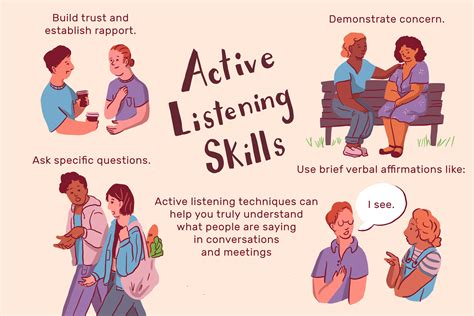Active Listening Definition, Skills, And Examples

Have you ever felt like someone was not really listening to you during a conversation? Perhaps you were talking to a friend about a problem, but they kept checking their phone or interrupting you. Unfortunately, this is a common experience for many people. Active listening is a communication skill that can help you become a better listener and improve your relationships with others. In this post, we will explore the definition of active listening, the skills involved, and provide examples to help you become an active listener.
What is Active Listening?
Active listening is a communication technique that requires the listener to fully concentrate, understand, respond, and remember what is being said. It involves paying attention to both verbal and nonverbal cues, asking questions for clarification, and providing feedback to the speaker to show that you are engaged in the conversation. Active listening is a skill that can be developed with practice and can benefit both personal and professional relationships.
The Importance of Active Listening
Active listening is important because it helps to:
- Build trust and rapport with others
- Improve understanding and communication
- Reduce misunderstandings and conflicts
- Enhance problem-solving and decision-making
- Provide emotional support and empathy
Skills Involved in Active Listening
Active listening involves several skills that help the listener to fully engage in the conversation. These skills include:
1. Paying Attention
The first step in active listening is to pay attention to the speaker. This means putting aside distractions and focusing on the conversation. It also involves observing the speaker’s body language, tone of voice, and facial expressions to gain a better understanding of their message.
Example:
During a job interview, you pay attention to the interviewer’s questions, maintain eye contact, and nod your head to show that you are engaged in the conversation.
2. Withholding Judgment
Active listening requires the listener to withhold judgment and avoid making assumptions or jumping to conclusions. This means listening to the speaker’s perspective without criticizing or dismissing their ideas.
Example:
During a political debate, you listen to both candidates’ arguments without interrupting or showing bias towards one side.
3. Reflecting on What is Being Said
Active listening involves reflecting on what is being said and asking questions for clarification. This means paraphrasing the speaker’s message to ensure that you have understood it correctly.
Example:
During a therapy session, you reflect on what your therapist is saying and ask questions to gain a better understanding of their advice.
4. Providing Feedback
Active listening requires the listener to provide feedback to the speaker to show that they are engaged and interested in the conversation. This means responding with affirmations, nodding, and asking follow-up questions.
Example:
During a business meeting, you provide feedback to your colleagues by nodding your head and asking questions to clarify their ideas.
5. Remembering What is Being Said
Active listening involves remembering what is being said and recalling it later when needed. This means taking notes or mentally summarizing the speaker’s main points.
Example:
During a lecture, you take notes to remember the professor’s main points and refer back to them later when studying for an exam.
Examples of Active Listening
Here are some examples of active listening:
1. Personal Relationships
Active listening can improve personal relationships by helping to build trust and understanding. For example, when talking to a friend about their problems, you can actively listen by:
- Putting away distractions and focusing on the conversation
- Asking questions to clarify their message
- Providing feedback by nodding and responding with affirmations
- Recalling the conversation later and following up with your friend
2. Professional Relationships
Active listening can also improve professional relationships by enhancing communication and problem-solving. For example, during a business meeting, you can actively listen by:
- Listening to everyone’s ideas without interrupting or criticizing
- Asking questions to gain a better understanding of their perspectives
- Providing feedback to show that you are engaged in the conversation
- Recalling the conversation later to follow up on action items
Conclusion
Active listening is a valuable skill that can help you become a better communicator and improve your relationships with others. It involves several skills, including paying attention, withholding judgment, reflecting on what is being said, providing feedback, and remembering what is being said. By practicing active listening, you can enhance your personal and professional relationships, reduce misunderstandings, and improve problem-solving and decision-making.
FAQs
1. What are the benefits of active listening?
Active listening can help to build trust and rapport with others, improve understanding and communication, reduce misunderstandings and conflicts, enhance problem-solving and decision-making, and provide emotional support and empathy.
2. How can I improve my active listening skills?
You can improve your active listening skills by paying attention, withholding judgment, reflecting on what is being said, providing feedback, and remembering what is being said. It takes practice and patience to develop these skills, but the benefits are worth the effort.
3. How can active listening benefit my professional life?
Active listening can benefit your professional life by enhancing communication and problem-solving skills. It can help you to build better relationships with colleagues, reduce misunderstandings, and improve decision-making.
